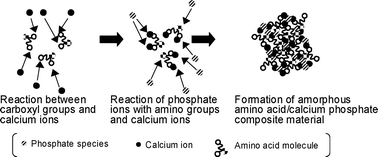Amorphous calcium phosphates can be obtained successfully in the presence of L-glutamic acid (Glu), L-aspartic acid (Asp), and L-lysine (Lys) with carboxyl and amino groups that are present in biomolecules such as collagen. Composition (Ca/P molar ratio) of the inorganic frameworks was controllable according to the kind of the organic molecules used. Ca- (Ca/P ≈ 1.8) and P-rich (Ca/P ≈ 1.0) products were obtained using dicarboxylic acid- (Glu and Asp) and diamine-type (Lys) amino acids, respectively. The amino acid containing calcium phosphates were transformed into apatite much faster than α-tricalcium phosphate (α-TCP) when immersed in simulated body fluid (SBF). The addition of the Ca-rich composites to calcium phosphate cement promoted the transformation into apatite, indicating that the amino acid containing amorphous calcium phosphates are highly promising as precursors for bone substitutes.
